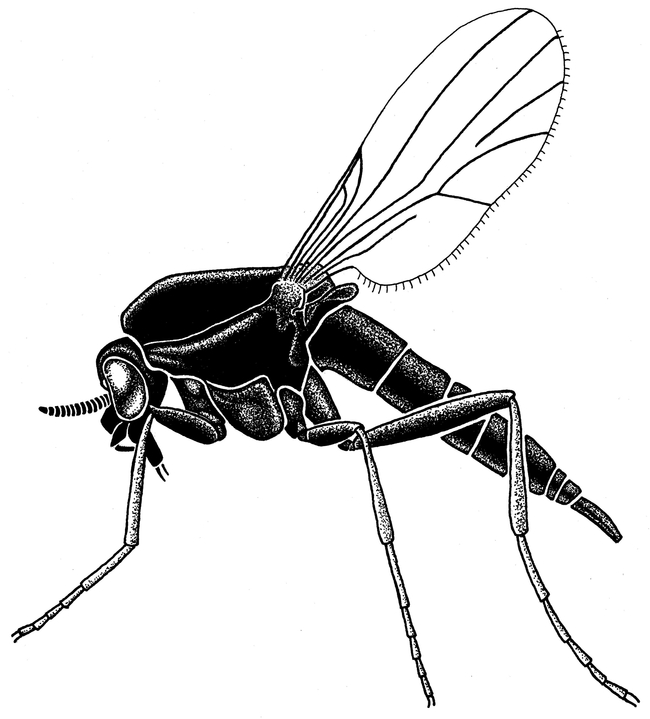Advice for the Home Gardener from the
Help Desk of the UC Master Gardener Program
of Contra Costa County
Request: We have lived in our house for 22 years in central County. Just the past few years we have been plagued by “no-see-ums” as the weather starts to warm. They are generally gone by the time it's hot.
Of course, the no-see-ums chase us indoors during the best time of year for gardening, socializing and enjoying the out-of-doors. Last year I spent time online researching how to prevent this pesky critter. I remember reading somewhere (?) a process for treating the yard to prevent their “hatch". Unfortunately, I can't find what I read, only how to prevent bites.
Can you help me with this? We have no lawn at the house, just trees and plants surrounded mostly by bark. I thought there was something you could spray or spread on the bark ground cover.
I will appreciate any advice you can share. Thank you in advance.
CCMG Help Desk Response: Thank you for contacting the UC Program Master Gardner Help Desk with your question concerning those pesky No-See-Ums you are battling. My childhood was spent in Vermont where these pesky flies breed in epic proportions in the summer, making life outdoors miserable. I sympathize with your frustration.
These minuscule flies are in the Ceratopogonidae family of flies commonly known as no-see-ums, also referred to as sand flies, gnats and biting midges. This family includes more than 5,000 species, distributed worldwide, with the exception being the Antarctic and the Arctic.
Like mosquitoes, No-See-Ums lay their eggs in moist areas. Both males and females consume nectar and other sweet juices for nourishment. Females, however, will also seek out a blood meal to fuel egg production. Female No-See-Ums will bite humans, pets, livestock, wild animals and birds. They breed and develop in moist wet areas. With her need for blood satisfied, the impregnated female will seek out an appropriate place to lay her eggs, which can include water-retaining hollows in trees, muddy water, wet sand, and other similar areas. About 28 days later, adult No-See-Ums emerge and the cycle begins again. No-See-Ums can be more difficult to get rid of than mosquitoes. They are smaller than mosquitoes and more agile fliers.
The research on control leans heavily to “exclusion” techniques as opposed to chemical treatment, misting and fogging. Chemical treatments have proven, in testing, to have little to no effect. If spraying or treating with chemicals is not effective there is little sense in spending your time and money in addition to adding the pollutant to your environment. While exclusion is the preferred control method you should look your property over and make sure you do not have “wet'” breeding sites.
Exclusion techniques appear to be the most effective method of control. These include wearing protective clothing, installing ultra-fine mesh screening (US 16 Standard Mesh) in-home screens and enclosing patio and porch areas with this same fine mesh screening. If you are really determined to be outside there are also pop-up tents designed with drop-down screening fine enough to block the No-See-Ums.
Topical sprays have proven to be only barely effective but might add a bit of protection while working in the garden. You could use a mosquito repellent with DEET, in addition to wearing protective clothing.
There is some information that refers to trapping as being moderately effective to highly effective, the trap tested is the CO2 mosquito trap. A home version is not too expensive and might be worth a try. No-See-Ums and mosquitos breed in the same conditions so you would be controlling any potential mosquito population as well, it might be a win-win.
The UC information on gnats was very limited. The Bug Squad from UC Davis provides some more detailed information at https://ucanr.edu/blogs/bugsquad/index.cfm?tagname=Valley%20Black%20Gnats. The best information I found was a link to research-based information from the University of Arizona. https://cals.arizona.edu/apmc/docs/No-See-Ums-IPMShort.pdf
I hope you will find some success by employing these methods. The best method may be the passage of time and the increase in temperature.
Please do not hesitate to call us with more questions …hopefully we will find some new information on the control of No-See-Ums.
Help Desk of the UC Program of Master Gardeners of Contra Costa County (BHD)
Notes: Contra Costa MG's Help Desk is available almost year-round to answer your gardening questions. Except for a few holidays (e.g., last 2 weeks December), we're open every week, Monday through Thursday for walk-ins from 9:00 am to Noon at 2380 Bisso Lane, Concord, CA 94520. We can also be reached via telephone: (925) 608-6683, email: ccmg@ucanr.edu, or on the web at http://ccmg.ucanr.edu/Ask_Us/. MGCC Blogs can be found at http://ccmg.edu/HortCoCo/ You can also subscribe to the Biog.
